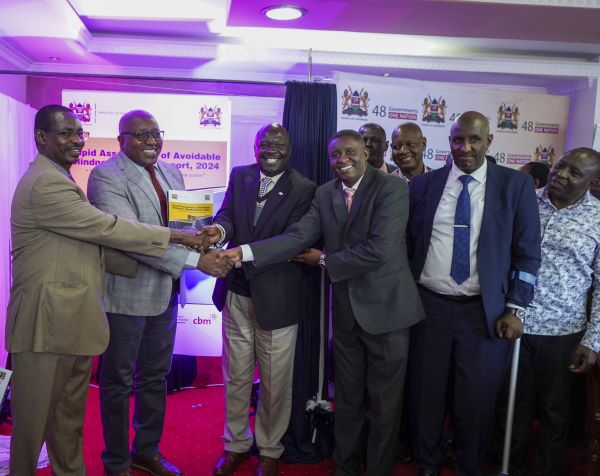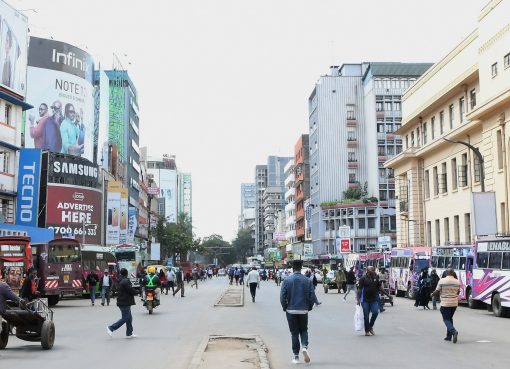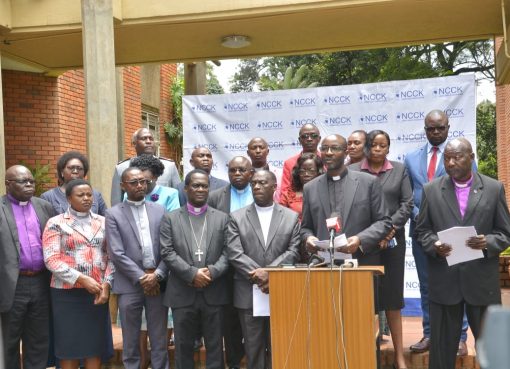At least Four in every a thousand Kenyan are blind or suffers from optical related ailments and need urgent eye care to reverse the trend, a survey has revealed.
According to a Rapid Assessment of Avoidable Blindness (RAAB) report , 2024, although the burden has reduced from 0.7percent in the 1990s to 0.4 percent going by latest figures aggravating the needs for optical health services.
According to the Study, one glaring eye condition is cataract which remains the leading cause of the blindness and yet it can be corrected through a cost effective surgical procedure.
The report shows that Cataract, uncorrected refractive errors of glaucoma contribute to about 85 percent of visual impairments.
Speaking during the launch of the RAAB report Health Cabinet Secretary Dr. Deborah Barasa said the survey conducted in 15 Counties between December 2022 and December 2023 at a cost of Ksh 100 million has shown significant reduction about 47 percent.
In a speech read on her behalf by Andrew Rukaria, the Secretary of Administration within the State Department of Medical Services the CS added that while the progress is commendable, there was growing demand for quality eye care as more patients sought treatment.
“Some of this increased need is linked to advancements in technology and development as it is estimated that slightly over 20 percent of Kenya’s population has access to eye health services in both public and private health facilities”, she said
With the findings in the report, the CS said the ministry was well positioned to articulate priority policy issues related to eye health, and the counties are effectively guided in their planning for eye-care.
“The RAAB findings also provide a solid baseline for monitoring United Nations (UN) targets for Universal Health Coverage, specifically effective Cataract Surgical Coverage and effective Refractive Error Coverage to support the formulation and implementation of eye health policies and plans aimed at achieving Universal Health Coverage”, Dr. Barasa said
She said Social Health Authority (SHA) which plays a crucial role in eye health financing and confirming that detailed economic analysis conducted in the Country over the past decade indicated that eye care interventions yielded a return on investment of four to six times making them a strong investment case.
The CS thanked Christian Blind Mission (CBM) and Fred Hollows Foundation for their support of the RAAB survey process as well as the technical teams from Health department for the enormous work done in the data collection .
“I believe that by the year 2030, we will witness the positive outcomes of the interventions proposed in today’s dissemination, leading to a further reduction in the burden of eye conditions and increased access to higher quality eye care”, Dr. Barasa said
Representing the Committee of health of Council of Governors (CoG) , Dr. Wilber Otichillo , Vihiga County Governor said eye health investments are important for all sectors and that preventing eye conditions and visual impairment leads to improved productivity and quality life.
He noted that with improved life expectancy , if the increase in the number of senior citizens is not met with (1:38) increased access to eye care services, there will be substantial increase in the number of people (1:44) with vision impairment and blindness.

“This RAAB survey is a critical milestone in our bid to achieve universal health coverage since it provides a quick and cost-effective method to gather essential data and insights for planning and for prioritization of eye health services”, he said .
Dr. Otichillo reiterated County Governments’ commitment to discuss the key survey results and recommendations to shape services and be more efficient in provision of eye care.
“We therefore need to ensure that our health facilities can safely handle the leading cause of blindness which is cataract with the desired quality and outcomes considering uncorrected refractive errors are also a major cause of visual impairment”, the Governor noted
He further challenged , saying there is need to ensure that allocation of spectacles in the social health insurance is sufficient to address the challenge of getting spectacles.
He encouraged Counties to ensure that their referral hospitals had the capacity to offer high-quality refractive error services adding that the Council of Governors recommends a people-centered approach to address eye health issues, one that brings together all the key stakeholders towards one goal.
We need to strengthen eye health systems by not only investing in infrastructure, human resources, and equipment in our hospitals so that they can offer safe, equitable, and high-quality eye care services, but also integrate the eye health services across all levels of care including community health services and primary health care”, Dr. Otichillo said .
The RAAB survey lays the groundwork for coordinated, impactful response to avoidable blindness and helping the country to achieve universal eye health and leaving no one behind.
Peter Milo, Country Director Fred Hollows foundation said the current eye health needs accounts for more than 85 percent of the causes of blindness.
“Uncorrected Refractive Errors (URE) stands at 52.6 percent, Untreated Cataract at 33.2 percent and glaucoma and other posterior segment diseases at 6.2 percent in that order, also contributing to more than 85 percent of visual impairment (excluding the blind category)”, he explained.
He explained that one (1) USD invested in Cataract surgeries has return on investment of USD 52.1 in Kenya on labor productivity and economy.
“We are advocating for a world in which no person is needlessly blind or visually impaired and our purpose is to deliver bold eye solutions that transform lives”, Milo said adding that Since 2017 to date in Kenya they have invested Ksh 220 million on Equipment to Counties and National Referral Hospitals.
CBM Country Director David Munyendo said they work in 11 Counties and another 10 counties through outreach programmes.
‘We have assisted in surgeries of more than than 9,000 people dispensed 143,000 spectacles, fitted over 800 clients and screened over 3.6 million people”, he added
Munyendo said they are open to working with Counties in continuous investment in particular supporting counties to integrate eye care services and helth into primary health care systems and also by developing county specific eye health action plans and also Council of Governors to develop a mains streaming framework on disability in all counties
According to the survey findings, if the challenge of Cataracts was to to be addressed , close to 60 percent of the blindness will be solved and considering that 80 percent of the problems that are causing a blindness are treatable or preventable there is need to address the 80 percent of them.
Overall, 10 surveys covering 15 counties was done in the Counties of Kiambu/ Muranga, Vihiga, Bomet, Nakuru, Kajiado, , Embu/ Meru/ Tharaka Nithi, Kakamega/ Busia , Kwale, Turkana, Homabay and Migori.
The survey involved 870 sub-locations, about 38,000 people of 50 years and above and that was about 92 percent of the target population, which was above 90 percent that was expected.
The survey also identified three key barriers to accessing eye care being the cost of cataract surgery services, hence the urgent need for those seeking related corrective services and diagnosis and lack of awareness about treatment opportunities for cataract.
According to the Ministry of Health, An estimated 30 percent of Kenyans who make up 7.5million have eye diseases requiring eye health services to avoid loss of sight.
By Wangari Ndirangu





